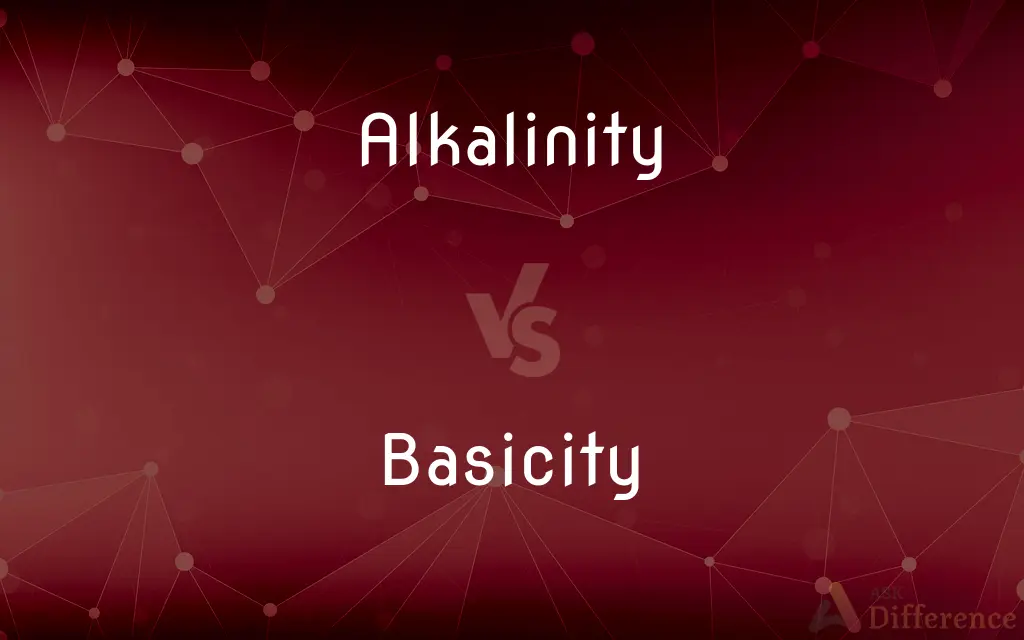Alkalinity vs. Basicity — What's the Difference?
By Tayyaba Rehman — Updated on September 30, 2023
Alkalinity is the capacity of water to neutralize acids, measured by the amount of acid required to lower the pH to a specific level; Basicity refers to the presence and concentration of basic (alkaline) substances in a solution, determining its pH level.

Difference Between Alkalinity and Basicity
Table of Contents
ADVERTISEMENT
Key Differences
Alkalinity and Basicity, while related, refer to different chemical properties. Alkalinity is a measure of the ability of a solution, typically water, to neutralize acids, preventing changes in pH, and is usually expressed in terms of equivalent concentrations of calcium carbonate. It provides insight into the buffering capacity of water, indicating its resistance to pH changes when acidic substances are added. In contrast, Basicity is a more general term that refers to the presence and concentration of basic (alkaline) substances in a solution, often reflected by the pH level, with higher basicity indicating a higher pH level, generally above 7.
Alkalinity is significant in environmental science and water treatment processes. It plays a crucial role in maintaining the ecological balance of aquatic environments by preventing sudden changes in pH levels, which could be harmful to aquatic life. Alkalinity ensures the stability of aquatic ecosystems by counteracting the effects of acidic pollutants. On the other hand, Basicity is a fundamental concept in chemistry, essential for understanding the chemical behavior of substances. It helps in categorizing substances based on their acidic or basic nature, enabling the prediction of reactions and interactions between different chemical entities.
In practical terms, Alkalinity is crucial in water quality management, ensuring the safety and suitability of water for consumption and industrial use. High alkalinity in water can help in neutralizing acids, but excessively high levels can lead to scaling in pipes and equipment. Basicity, on the other hand, is utilized across various chemical applications, including titration methods to determine the concentration of acidic solutions, and in the formulation of products like soaps and detergents, where the basicity of compounds is manipulated to achieve the desired properties.
While Alkalinity specifically relates to the acid-neutralizing capacity of water, affecting its suitability for consumption and use, Basicity encompasses the broader presence of basic substances in solutions, impacting their chemical behavior and interactions. Both concepts are pivotal in different fields, with alkalinity being central to water quality and environmental science, and basicity being integral to the study and application of chemistry.
In essence, Alkalinity and Basicity represent distinct yet interconnected aspects of chemical science. Alkalinity’s focus on neutralizing capacity is vital for environmental stability and water quality, while Basicity’s emphasis on the nature and concentration of alkaline substances is crucial for chemical analysis and product formulation.
ADVERTISEMENT
Comparison Chart
Definition
Acid-neutralizing capacity of water
Presence and concentration of basic substances in a solution
Field of Relevance
Environmental science, water treatment
General chemistry, product formulation
Application
Water quality management, ecological balance
Chemical analysis, titrations, substance categorization
Measurement
Equivalent concentrations of calcium carbonate
PH level
Importance
Maintains pH stability in aquatic environments
Determines chemical behavior of substances
Compare with Definitions
Alkalinity
Alkalinity is crucial in maintaining ecological balance in aquatic environments.
The alkalinity of river water was monitored to detect any imbalances that could affect the ecosystem.
Basicity
Basicity refers to the quality of being basic, determined by the concentration of basic substances in a solution.
The basicity of the cleaning solution was assessed to ensure it was suitable for sensitive surfaces.
Alkalinity
Alkalinity is the measure of a solution’s ability to neutralize acids, preventing pH changes.
High alkalinity in the lake helps in maintaining a stable pH level, supporting aquatic life.
Basicity
Basicity is an integral concept in chemistry, helping categorize substances as acidic, basic, or neutral.
Understanding the basicity of different compounds is crucial in predicting their chemical reactions.
Alkalinity
Alkalinity reflects the buffering capacity of water, representing its resistance to acidic substances.
The alkalinity of the water sample was tested to ensure it could neutralize acidic pollutants effectively.
Basicity
Basicity is important in various chemical applications, including titrations and product formulations.
The basicity of the solution was manipulated to formulate an effective detergent.
Alkalinity
Alkalinity is usually expressed in equivalent concentrations of calcium carbonate.
The water’s alkalinity was measured as 150 mg/L of calcium carbonate.
Basicity
Basicity can be manipulated to achieve desired properties in chemical products like soaps and detergents.
The product’s efficacy was enhanced by adjusting the basicity of its components.
Alkalinity
Alkalinity is significant for water quality, impacting the suitability of water for consumption and use.
The water treatment plant regularly checks the alkalinity of water to ensure it is safe for consumption.
Basicity
Basicity affects the pH level of solutions, with higher basicity resulting in a higher pH.
The high basicity of the solution indicated a pH level above 7.
Alkalinity
The alkali concentration or alkaline quality of an alkali-containing substance.
Basicity
Of, relating to, or forming a base; fundamental
“Basic changes in public opinion often occur because of shifts in concerns and priorities” (Atlantic).
Alkalinity
(chemistry) The state of being, or the degree to which a thing is, alkaline.
Basicity
Of, being, or serving as a starting point or basis
A basic course in Russian.
A set of basic woodworking tools.
Alkalinity
The quality which constitutes an alkali; alkaline property.
Basicity
Of or relating to a base.
Alkalinity
PH values above 7
Basicity
Containing a base, especially in excess of acid.
Basicity
Alkaline.
Basicity
(Geology) Containing little silica, as certain igneous rocks.
Basicity
(Slang) Unthinkingly or blandly conformist
“Even someone who looks really indie … can be basic if they are simply imitating others rather than thinking for themselves” (Chelsea Rickling).
Basicity
An essential, fundamental element or entity
The basics of math.
Basicity
Basic training.
Basicity
(uncountable) The condition of being basic.
Basicity
The degree to which a substance is basic: its pH level.
Basicity
The number of replaceable hydrogen atoms in a molecule of an acid.
Basicity
The quality or state of being a base.
Common Curiosities
Is Basicity a central concept in chemistry?
Yes, Basicity is a fundamental concept in chemistry, essential for understanding and categorizing the chemical behavior of substances.
What does Alkalinity measure?
Alkalinity measures the capacity of water to neutralize acids, reflected by the amount of acid required to lower the pH to a specific level.
What does Basicity represent?
Basicity represents the presence and concentration of basic (alkaline) substances in a solution, influencing its pH level.
In what applications is Basicity relevant?
Basicity is relevant in chemical analysis, titrations, and the formulation of chemical products like soaps and detergents.
Why is Alkalinity important in environmental science?
It is crucial for maintaining ecological balance in aquatic environments by preventing sudden changes in pH levels, protecting aquatic life.
Is Alkalinity critical for water quality management?
Absolutely, Alkalinity is vital for determining water's suitability for consumption and industrial use and ensuring ecological stability in aquatic environments.
Does Alkalinity indicate the buffering capacity of water?
Yes, Alkalinity reflects the buffering capacity of water, indicating its resistance to pH changes due to acidic substances.
How is Alkalinity expressed?
It is usually expressed in terms of equivalent concentrations of calcium carbonate.
Can Basicity determine the pH level of a solution?
Yes, the basicity of a solution directly influences its pH level, with higher basicity indicating a higher pH.
How does Basicity affect chemical reactions and interactions?
Basicity helps in categorizing substances as acidic or basic, allowing the prediction of reactions and interactions between different chemical entities.
Share Your Discovery

Previous Comparison
Election vs. Poll
Next Comparison
Allocate vs. DistributeAuthor Spotlight
Written by
Tayyaba RehmanTayyaba Rehman is a distinguished writer, currently serving as a primary contributor to askdifference.com. As a researcher in semantics and etymology, Tayyaba's passion for the complexity of languages and their distinctions has found a perfect home on the platform. Tayyaba delves into the intricacies of language, distinguishing between commonly confused words and phrases, thereby providing clarity for readers worldwide.
















































